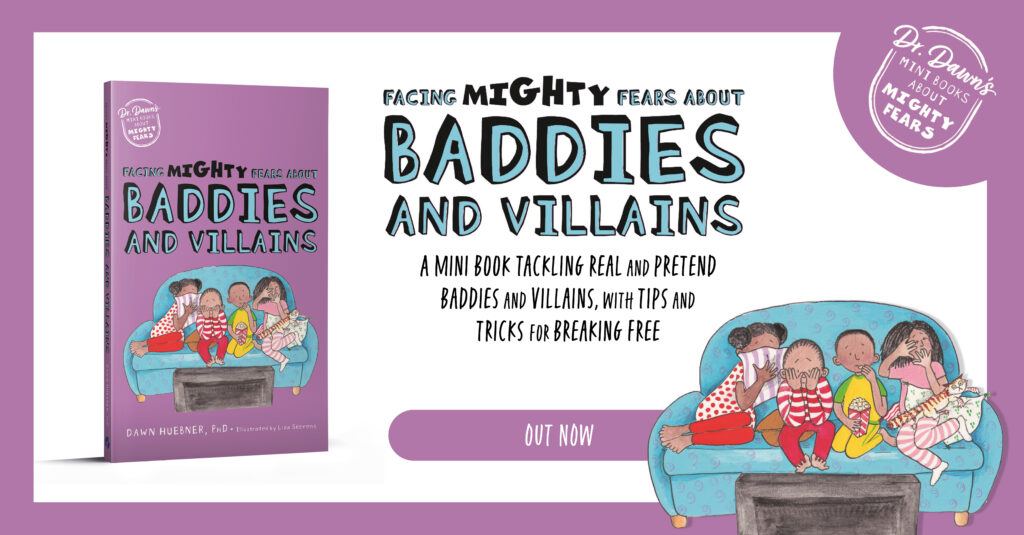This blog post was written by Dr. Dawn Huebner and includes an excerpt from the newest book in her Dr. Dawn’s Mini Books About Mighty Fears series, Facing Mighty Fears About Baddies and Villains.
We want children to feel safe. To be able to navigate their houses, their schools, their towns without the looming fear that someone will snatch them, or something terrible will happen. Yet for some children, that isn’t the way it is.
It’s tricky, because sometimes the world isn’t safe for children. Sometimes they hear about credible threats, and then we need to help them put those threats into perspective. There are resources for children living with trauma, and for children who are safe but have learned about a real-world scary thing (for example, Something Bad Happened). That’s not what this post is about.
This post is about children who live in safe houses, on safe streets, in safe neighborhoods, yet still feel afraid. Children whose fear far outstrips the likelihood of danger. And especially, children afraid of “baddies.”
Baddy might not be the term you or your child use. Your child might say bad guy, or monster, or villain. They might refer to the character in a movie, or book, or urban legend. The baddy might be real or fictional but either way, they do not pose a risk to your child. And yet, your child feels afraid.
The first course of action is typically to reassure. If you have reassured your child, great. If that’s taken care of the problem, even better. But for some children, reassurance doesn’t stick. They continue to ask questions, check locks, bury their heads under blankets. If this sounds familiar, it’s time to try something different.
From Facing Mighty Fears About Baddies and Villains, note to Parents and Caregivers:
There is a loop that forms for anxious children, one that is easy to get started and hard to end. In this loop, your child feels afraid, so they do something self-protective like ask for reassurance or refuse to go upstairs alone. And then when the thing they fear doesn’t happen, they think, “Whew. It’s a good thing I got my dog, or my sister, or my dad, to come upstairs with me.” And they mistakenly believe that the actions they took were necessary, when the truth is that they were never in danger to begin with.
When you go along with your child’s self-protective behaviors, it’s like you are saying, “I agree with what you are doing. You really are in danger.” That is not the message you want to be sending. Instead, your child needs help moving away from their (unnecessary) self-protective behaviors.
The key, of course, is exposure. Exposure means having your child face their fear, on purpose, intentionally, repeatedly, one small step at a time. It is the gold standard in the treatment of anxiety, and it works. Getting children to cooperate is another story.
That’s where this book comes in. Facing Mighty Fears About Baddies and Villains teaches 6-10-year-olds the skills they need to move away from unnecessary self-protective behaviors while directly facing their fear. It normalizes the fear of baddies while motivating children to respond in new and more effective ways. Like all the books in this series, there are Fun Facts cleverly tied to the guiding metaphor, in this case, gum. The idea is that you can “chew” out the scariness of your thoughts by engaging with rather than avoiding them. Children who read this book will feel understood and, importantly, empowered. And parents or other caregivers will find the guidance they need.
Facing Mighty Fears About Baddies and Villains is out now! Check out the rest of the Dr. Dawn’s Mini Books About Mighty Fears series here!

